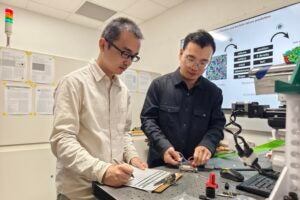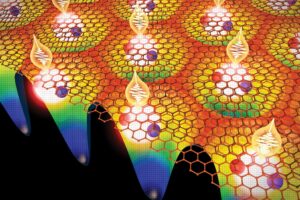Sean Riley had an unusual problem. Riley, a violinist, had fallen in love with a piece of music he could not play.
His struggle had nothing to do with his talent. He has been performing since he was 7 years old. Riley holds bachelor’s and master’s degrees in violin performance from The Juilliard School, and he is currently a Doctor of Musical Arts candidate at The University of Texas at Austin’s Butler School of Music. He even played for Prince Charles at his 65th birthday.
The problem was that his prized 240-year-old violin has four strings like most violins, but this piece of music was written for six strings.
“I have made it a point in my career to keep an eye out for incredible new music,” said Riley. “ ‘The Dharma at Big Sur’ is written by a composer named John Adams, one of the greatest composers in the world at the moment.”
He found the composition while looking in the Fine Arts Library for one of Adams’ other pieces, his first violin concerto.
“ ‘The Dharma at Big Sur’ was sitting right next to it. I opened it up, turned my phone on and listened to it. It was amazing. I had to play it,” he said.

The piece is haunting and rhythmic. It swells with high notes and extra low notes — the reason the six strings are needed. The extra two strings allow the violin to enter cello range, with low F and low C strings.
At many points in the piece, the music drops off suddenly, which the composer says is inspired by the dizzying heights and current rhythms of the Big Sur coast in California.
Contemporary pieces such as this are often challenging to play because the musician hasn’t heard it played again and again. This is part of what draws Riley to them, the challenge and the excitement of being part of something new.
“I was walking around the library thinking about how to acquire the rare six-string electric violin needed to play the piece and had to pass the Foundry to check out the book,” said Riley.
The Foundry is a makerspace in the Fine Arts Library. It is open to all UT Austin students, faculty members and staffers. There are laser cutters, 3-D printers, textile machines and computers with design software — pretty much any equipment you would need to bring a creative project to life.
“The idea clicked right there,” he said. “I could make it.”
Electric violins cost thousands of dollars, but Riley thought if he was able to print one on the 3-D printers, it would be significantly cheaper (hundreds of dollars), and it would be unique.
At the Foundry, he met Daniel Goodwin, a mechanical engineering senior who graduated from the Cockrell School of Engineering this past fall.
“I was working there at the time,” said Goodwin. “Sean came in wanting to make this six-string violin. I asked him what his background was. He said, ‘I’m a violinist.’ I said, “You’re crazy.’ ”
As wild as the idea was, Goodwin was also excited by a challenge and signed on to help Riley bring his vision to life. They sat down right there in the library and started designing.
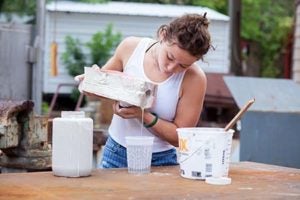
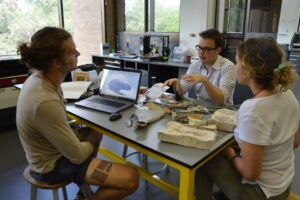
Together, they embarked on a project that took about a year to finish. They enlisted the help of Rebecca Milton, a sculptor and studio art major in the College of Fine Arts, to create the look of the instrument.
“I wanted someone to take this project beyond just a violin,” said Riley.
The sound of the violin comes from an electric violin pickup that Riley ordered from a New York company that specializes in handmade parts. The pickup amplifies the string resonance by attaching to the bridge area of the violin and converting the vibrations of the strings into a digital signal.
This means the electric violin doesn’t require the standard hollow-body shape of an acoustic violin, and these mechanics gave the team room for creativity. Milton was inspired by the coastal origin of the musical piece and created a mold from driftwood, bones and shells. She poured porcelain that was attached around the 3-D-printed neck and body design.
“All these various people came together in a way that he might not have planned or expected, but it happened because of a space like this,” said Lorraine Haricombe, vice provost and director of libraries at UT Austin.
This kind of project is exactly what planners at UT Libraries and the College of Fine Arts hoped for when they opened the Foundry to all UT students, faculty members and staffers in the fall of 2016.
Now that the violin is complete, Riley says he is thrilled with the results. The sound is excellent, nuanced and full bodied, and it is ready for the stage. If you closed your eyes, you would never know that this was a DIY instrument.
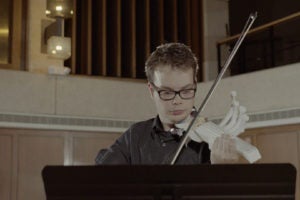
“I’m most proud of my team. They have been amazing and brilliantly patient with all the shenanigans that a project into such uncharted territory entails,” he said. “It’s hard to describe how amazing it feels to hold the violin in my hands. I can feel that it has been made. I can feel Daniel’s hard work. I can feel Rebecca’s hard work. I feel like I’m not even playing a violin any more. It’s something different.”
Riley is currently practicing on the new violin and will perform his first recital with it at 4 p.m. Feb. 22 in Jessen Auditorium. His final Doctor of Musical Arts recital next semester will focus on the new instrument. Both recitals will be open to the public.
The next challenge: lots of practice. “I’ve logged well over 30,000 hours on regular violins. On the one that we created, I’m still in the double digits,” he said. The new instrument will take some time to master, but Riley said he is looking forward to it.
Funding for the project came from a Rainwater Innovation Grant. Riley was one of seven student recipients to get small grants to cover independent projects that advance the study of American music.


